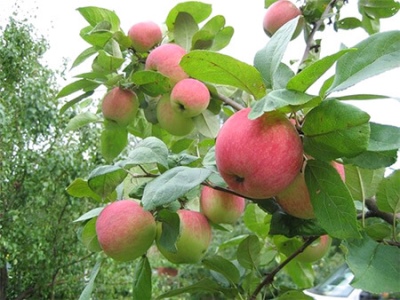
- Authors: Sverdlovsk Experimental Gardening Station, author - L.A. Kotov
- Taste: sweet and sour
- Scent: average
- Fruit weight, g: 80-90
- Fruit size: below the average
- Yield: high, up to 160 kg per tree
- Frequency of fruiting: annual
- The beginning of fruiting varieties: for 3-4 years
- Ripening terms: summer
- Removable maturity: mid-August
The result of many years of breeding work has become another unique variety for cold regions. The fast-growing universal variety Serebryanoe Kopytse pleases Siberians with wonderful apples with excellent transportability, intended for fresh consumption and for canning.
Breeding history of the variety
The winter-hardy variety was bred at the Yekaterinburg Experimental Station. The originator is L.A. Kotov, who used the varieties Snezhinka and Raduga in his work to obtain a plant adapted to the conditions of Western Siberia, the Far Eastern and northern regions.
Description of the variety
The Silver Hoof is a medium-sized apple tree with a dense, rounded crown. The main straight branches are covered with light yellowish brown bark. Shoots are straight, dark-colored, slightly pubescent. The light green leaves of the apple tree are oval in shape with a rounded base and a short pointed tip. The middle of the leaf is slightly concave, thereby creating a certain resemblance to a boat. The flowers of the apple tree are medium in size.
Features, pros and cons
The peculiarity of the summer variety is mixed fruiting, when apples are formed on last year's shoots, as well as on spears and ringlets. Pros of the variety:
- good frost resistance;
- consistently high fruiting;
- ability for long-term storage.
Disadvantages - fruit crumbling in case of non-observance of agricultural technology and poor resistance to fungal diseases. However, these disadvantages can be called conditional, since they are easily leveled out if you apply effort and attention.
Ripening and fruiting
Silver Hoof has a summer ripening period: apples reach removable maturity by the second decade of August. At the same time, consumer capacity continues until the end of September. The variety begins to bear fruit annually from 3-4 years.
Growing regions
The variety is adapted for the Ural region and regions of Siberia, as well as for central Russia. It is successfully grown in the CIS countries.
Yield
The apple tree gives stable high yields: up to 160 kg per tree. Careful adherence to agronomic requirements can increase this figure.
Fruits and their taste
The composition of one-dimensional rounded fruits of the correct shape contains:
- dry soluble substances - from 12.5 to 17.8%;
- sugar - from 10.2 to 12.9%;
- titratable acids - 0.8%;
- ascorbic acid - 12.5 mg / 100 g;
- P-active substances (catechins) - 111.2 mg / 100 g.
Slightly ribbed apples are covered with dry, smooth skin with a slight touch of prune. The creamy surface is covered with an orange-red blush with pronounced striping and inconspicuous subcutaneous dots. Small fruits weigh 80–90 g. The juicy dense pulp has a fine-grained structure, a pleasant and rich sweet-sour taste and aroma. Keeping fruit up to 1.5 months. Apples are not prone to shedding.

Growing features
Stable and high yields depend on adherence to the rules of planting and caring for fruit trees.Sunny places are chosen for the apple tree. It is desirable that they be protected from drafts. The absence of groundwater within the reach of the roots of an adult tree is a prerequisite, otherwise constant moisture can lead to their decay.
The soil should be fertile, pH neutral, light and breathable. Planting dates are spring-autumn, however, for the northern regions, it is preferable to plant young plants in spring, so that they have time to get stronger and grow the root system over the summer.
For planting, standard pits 80x80 cm are prepared, there should be drainage at the bottom. The removed soil is mixed with humus, superphosphate, urea. To fasten a young, weak trunk, a peg is installed in the pit, to which an apple tree is then tied. After planting, the near-trunk circle is well spilled, then they make sure that the earth does not dry out and does not crack. Mulching and loosening will help with this.
With normal rainfall, the tree is watered in early spring and before flowering. In the dry season, watering is organized more often. Further care is sanitary and formative pruning. In spring and autumn, dry, diseased, frozen shoots are removed. Crown formation begins in the second year after planting.



Pollination
Silver Hoof refers to self-infertile plants, therefore, it is necessary to ensure its proximity to other varieties that are similar in flowering time: Anis Sverdlovsky, Zhigulevsky, White filling. This will ensure the largest number of ovaries.
Top dressing
After 2 years from the moment of planting, they begin to feed the apple trees, since the supply of nutrients originally introduced into the soil has already been depleted by this time. Top dressing is carried out in the spring (nitrogen substances), in the summer during the budding period (potassium-phosphorus fertilizers), in the fall, organic matter (humus, compost, bird droppings) is introduced.

Frost resistance
Silver Hoof perfectly tolerates northern winters, temperatures down to -40 ° C, and the variety is also resistant to recurrent spring frosts.

Diseases and pests
The variety is relatively resistant to fungal diseases and pests, rather resistant to scab.In any case, fruit trees need preventive treatments with insecticides and fungicides.

The apple tree is a popular fruit crop among gardeners. It can be found in many summer cottages. But at the same time, such trees are often affected by various diseases. It is very important to recognize the disease in time and carry out the necessary procedures for a speedy recovery. Otherwise, the fruits will be spoiled, and the tree itself may die altogether.












































































